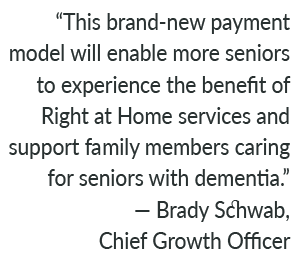by Rowan Report | Jan 16, 2025 | Partner News
Right at Home and PocketRN Enter Strategic Partnership to Provide New Medicare Care Model for Seniors with Dementia
Right at Home and PocketRN today announced a strategic partnership to provide support to Medicare dementia beneficiaries.
WASHINGTON, DC, UNITED STATES, January 15, 2025. Right at Home, a nationwide provider of in-home care, and PocketRN, a leading provider of virtual nursing care, today announced a strategic partnership to provide support to certain Medicare beneficiaries with dementia.
PocketRN was recently selected as a participant in the Guiding an Improved Dementia Experience (GUIDE) Model by the Centers for Medicare & Medicaid Services (CMS). As a GUIDE participant, PocketRN’s innovative “virtual nurse for life” approach will allow dementia patients and family caregivers to be specialty matched to nurses, who will become trusted companions that establish a long-term relationship with patients and families. PocketRN nurses also encourage openness to better understand individualized challenges; serve as continuous sources of education, coaching, monitoring, and emotional support; and are available as a 24/7 lifeline. Under the GUIDE Model, PocketRN will be available at no cost to eligible beneficiaries, with $0 copays.
 Right at Home will provide in-home care and safety assessments for eligible beneficiaries to evaluate the safety of the home environment, to assess the ability of the beneficiary to manage and function at home, and to report to PocketRN other environmental, social, and behavioral factors that might impact the function and needs of the beneficiary and their caregiver. PocketRN and Right at Home will use these valuable reports to bring other resources included in the GUIDE benefit package to better support the beneficiary and allow them to stay in their home longer.
Right at Home will provide in-home care and safety assessments for eligible beneficiaries to evaluate the safety of the home environment, to assess the ability of the beneficiary to manage and function at home, and to report to PocketRN other environmental, social, and behavioral factors that might impact the function and needs of the beneficiary and their caregiver. PocketRN and Right at Home will use these valuable reports to bring other resources included in the GUIDE benefit package to better support the beneficiary and allow them to stay in their home longer.
The GUIDE Model also provides respite services for certain people, enabling caregivers to take temporary breaks from their caregiving responsibilities. As part of its strategic partnership with PocketRN, Right at Home agencies will be providers of this key respite care service.
The anticipated outcomes of the GUIDE Model include increased caregiver empowerment and a reduction in Medicare and Medicaid expenditures–primarily achieved by preventing or delaying long-term nursing home stays. Additionally, the program aims to bring about a secondary reduction in hospital, emergency department, and post-acute care utilization. These outcomes closely align with the work that PocketRN is already doing and its mission to close the gap between home and healthcare.
“We couldn’t be more thrilled to bring our revolutionary nurse-led care model to the millions of dementia patients and families who need it most. With PocketRN, patients and families get unwavering support from a ‘virtual nurse for life’ as they navigate the complexities of managing dementia at NO cost to them. Nurses are hands-down the best clinicians to be the ‘glue’ to dementia patients and families throughout their journey–they’ve been doing so forever, and it’s high-time their work is valued by our system.”
CEO, PocketRN
“For over 25 years, Right at Home has empowered seniors to continue to live with independence and dignity while managing the effects of aging. This brand-new payment model will enable more seniors to experience the benefit of Right at Home services and support family members caring for seniors with dementia.”
Chief Growth Officer, Right at Home
GUIDE Model Participation
PocketRN will utilize its national network of expert nurses to dramatically expand access for dementia patients and families who otherwise may go without care. Its participation in the GUIDE Model will span eight years, with a one-year pre-implementation period for program development, community engagement, and infrastructure scaling before rolling out with a cohort of initial partners. Providers who are interested in partnering with PocketRN so their patients and families can get high-quality, personalized dementia care at no cost can contact nancy.gillette@pocketrn.com.
Founded in 1995, Right at Home offers in-home care to seniors and adults with disabilities who want to live independently. Most Right at Home offices are independently owned and operated and directly employ and supervise all caregiving staff. Each caregiver is thoroughly screened, trained, and bonded/insured before entering a client’s home. Right at Home’s global office is based in Omaha, Nebraska, with more than 700 franchise locations in the U.S. and five other countries. For more information about Right at Home, visit rightathome.net.
PocketRN gives patients, families, and caregivers a “virtual nurse for life.” Its mission is to close the gap between home and healthcare by: enabling nurses to care proactively and continuously at the top of their license, enabling caregivers with peace of mind and the confidence to support others, and enabling patients to access whole-person, trusted, empathetic care when and where they want it. PocketRN is the glue that holds together fragmented experiences in care so that partners, clinicians, patients, and families get back more of what they need: quality time. For more information, visit www.pocketrn.com.
This press release was originally submitted to and appeared on EIN Presswire and is reprinted with permission.
by Kristin Rowan | Jan 16, 2025 | Clinical
GUIDE Launched with 390 Participants
On July 1, 204, CMS launched the GUIDE Model and announced that 390 organizations had signed on to participate. The Guiding an Improved Dementia Experience (GUIDE) Model is a voluntary model test amied at supporting people with dementia and their unpaid caregivers (family members).
The GUIDE Model focuses on comprehensive, coordinated dementia care to improve the quality of life for people with dementia. It also hopes to reduce the strain on family caregivers and keep patients in their homes and communities longer. Medicare payments cover the package of care coordination, care management, caregiver education and support, and respite care.
Poor-Quality Dementia Care
The GUIDE Model aims to address the key drivers of poor-quality dementia care in five ways:
-
- Defining a standardized approach to dementia care delivery for model participants – this includes staffing considerations, services for people with dementia and their unpaid caregivers, and quality standards.
- Providing an alternative payment methodology to model participants – CMS provides a monthly per-beneficiary payment to support a team-based collaborative care approach.
- Addressing unpaid caregiver needs – the model aims to address the burden experienced by unpaid caregivers by requiring model participants to provide caregiver training and support services, including 24/7 access to a support line, as well as connections to community-based providers.
- Respite services – CMS pays model participants for respite services, which are temporary services provided to a beneficiary in their home, at an adult day center, or at a facility that can provide 24-hour care for the purpose of giving the unpaid caregiver temporary breaks from their caregiving responsibilities.
- Screening for Health-Related Social Needs – model participants are required to screen beneficiaries for psychosocial needs and health-related social needs (HRSNs) and help navigate them to local, community-based organizations to address these needs.
Aspects of GUIDE designed to improve health equity include:
-
- Requiring participating providers to implement HRSN screenings and referrals.
- Offering financial and technical support for development of new dementia care programs targeted to underserved areas with less access to specialty dementia care.
- Annual reporting by participants on progress towards health equity objectives, strategies, and targets.
- Using data from the model to identify disparities and target improvement activities.
- A health equity adjustment to the model’s monthly care management payment to provide additional resources to care for underserved beneficiaries.
PocketRN gives patients, families, and caregivers a “nurse for life,” closing the gap between healthcare and care at home. This whole-person support allows patients and their caregivers to have access to medical care through their virtual nurse, who establishes a relationship with the patients and families.
On January 13, 2025, PocketRN announced a Strategic Partnership with Nevvon to pilot the GUIDE Model.
Nevvon is a global home and health care training tech company that certifies caregivers for continuing education. The app-based learning allows caregivers to go at their own pace, simplifying compliance, and empowering agencies to deliver exceptional care.
On January 15, 2025, PocketRN announced a Strategic Partnership with Right at Home to provide support to eligible Medicare beneficiaries with dementia.
Right at Home is a nationwide provider of in-home care and will provide care and safety assessments for eligible beneficiaries to evaluate the safety of the home environment, the ability of the patient to manage and function at home, and report back to PocketRN any other factors that might impact the patient and their family caregiver.
Later today, PocketRN will announce a National Strategic Partnership with with Assisting Hands® Home Care to test the care model.
Assisting Hands provides in-home care to seniors, individuals with disabilities, and people recovering from illness or injury. The agency has a significant portion of their client base with a dementia diagnosis. Their franchise system has locations across the United States.
“We couldn’t be more thrilled to bring our revolutionary nurse-led care model to the millions of dementia patients and families who need it most. With PocketRN, patients and families get unwavering support from a ‘virtual nurse for life’ as they navigate the complexities of managing dementia at NO cost to them. Nurses are hands-down the best clinicians to be the ‘glue’ for patients and their families throughout their dementia journey–they’ve been doing so forever, and it’s high-time their work is valued by our system.”
CEO, PocketRN
The Rowan Report spoke with Nancy Gillette, Chief Growth Officer at PocketRN for this exclusive scoop. Nancy explained that with this program, PocketRN will be able to provide a nurse to dementia patients, provide a clinical overlay to care at home, work with care at home partners for respite benefits, and become a referral source when a home care agency has an eligible patient.
Existing models and studies using PocketRN have shown up to a 30% reduction in urgent care visits, ER visits, and hospitalizations. The company is focusing on finding new strategic partners for a greater understanding of patient engagement from a home care agency standpoint.
Nancy gave us this inside information:
The three recent announcements are just the beginning. Expect more announcements in the next 30-60 days and then continuing throughout the year.
PocketRN will eventually be applying the GUIDE Model in agencies, patients already using PocketRN, and direct referrals across all 50 states.
Kristin Rowan has been working at The Rowan Report since 2008. She is the owner and Editor-in-chief of The Rowan Report, the industry’s most trusted source for care at home news .She also has a master’s degree in business administration and marketing and runs Girard Marketing Group, a multi-faceted boutique marketing firm specializing in content creation, social media management, and event marketing. Connect with Kristin directly kristin@girardmarketinggroup.com or www.girardmarketinggroup.com
©2025 by The Rowan Report, Peoria, AZ. All rights reserved. This article originally appeared in The Rowan Report. One copy may be printed for personal use: further reproduction by permission only. editor@therowanreport.com
by Kristin Rowan | Feb 21, 2024 | Admin, Clinical
By Kristin Rowan, Editor
The workforce shortage across the country both in and out of home care is creating increasing demand on workers and added stress on organizations. Added to this is the increasing number of older adults living past retirement age. As more and more “boomers” reach that age, more of them are considering aging in place rather than moving to a facility. High turnover rates among care providers also contributes to the workforce shortage for care at home agencies.
One agency has a plan to increase its workforce by 50% by the end of the year. Right at Home, based in Omaha, Nebraska, has more than 700 franchise locations and employs more than 45,000 caregivers. They intend to add 26,000 additional caregivers to address the growing needs of our aging population.
Recruitment and retention issues are not specific to care at home, but the compounding factors of a larger aging population and higher turnover rates make it a pressing issue. It may seem like a lofty goal to increase an already large workforce by another 50% when many businesses are struggling to hire at all. Right at Home has implemented several strategies to reach this goal:
- Preferred partnerships with job boards
- Collaborations with local and national job platforms working directly with franchise owners
- Technology solutions
- Increased efficiencies in the office gives staff more time and energy for hiring and onboarding
- Electronic onboarding resources and automated communication within applicant tracking systems to simplify hiring process
- Engagement platforms to reward and recognize caregivers to lower turnover rates
- Cultivating an appealing culture
- Becoming the employer of choice in each demographic area
- Breaking down the caregiver experience into micro elements for a better experience for caregivers
Creating partnerships with job boards and using automated processes for hiring are the simplest of these tasks to implement right away. Larger job boards like Indeed and Monster may not be willing to collaborate, but local colleges may be an easier route. They typically have job boards with smaller pools of applicants who are already partitioned into fields of study. No matter the size of your agency, there are technology solutions to reduce the time spent with onboarding and applicant tracking that are cost effective and increase efficiency. If you’re looking for one, we’ve reviewed several over the years.
Cultivating an appealing culture may be more difficult. An appealing culture is subjective and vague. Right at Home mentions breaking down the caregiver experience into micro elements. Even if you know what those micro elements are, improving the experience is the goal but not a plan. In a recent conversation with home care agency owner Bob Roth, he mentioned the difficulties of establishing leadership and creating culture in a dispersed workforce. This topic bears additional scrutiny and we will have some upcoming articles on creating culture in the next few weeks.
# # #
Kristin Rowan has been working at Healthcare at Home: The Rowan Report since 2008. She has a master’s degree in business administration and marketing and runs Girard Marketing Group, a multi-faceted boutique marketing firm specializing in event planning, sales, and marketing strategy. She has recently taken on the role of Editor of The Rowan Report and will add her voice to current Home Care topics as well as marketing tips for home care agencies. Connect with Kristin directly kristin@girardmarketinggroup.com or www.girardmarketinggroup.com
©2024 by The Rowan Report, Peoria, AZ. All rights reserved. This article originally appeared in Healthcare at Home: The Rowan Report.homecaretechreport.com One copy may be printed for personal use: further reproduction by permission only. editor@homecaretechreport.com

 Right at Home will provide in-home care and safety assessments for eligible beneficiaries to evaluate the safety of the home environment, to assess the ability of the beneficiary to manage and function at home, and to report to PocketRN other environmental, social, and behavioral factors that might impact the function and needs of the beneficiary and their caregiver. PocketRN and Right at Home will use these valuable reports to bring other resources included in the GUIDE benefit package to better support the beneficiary and allow them to stay in their home longer.
Right at Home will provide in-home care and safety assessments for eligible beneficiaries to evaluate the safety of the home environment, to assess the ability of the beneficiary to manage and function at home, and to report to PocketRN other environmental, social, and behavioral factors that might impact the function and needs of the beneficiary and their caregiver. PocketRN and Right at Home will use these valuable reports to bring other resources included in the GUIDE benefit package to better support the beneficiary and allow them to stay in their home longer.







